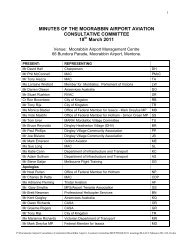Circuit Training at Moorabbin Airport Circuit Training at Moorabbin ...
Circuit Training at Moorabbin Airport Circuit Training at Moorabbin ...
Circuit Training at Moorabbin Airport Circuit Training at Moorabbin ...
You also want an ePaper? Increase the reach of your titles
YUMPU automatically turns print PDFs into web optimized ePapers that Google loves.
CIRCUIT TRAINING<br />
<strong>Circuit</strong> training, the act of repetitive take‐offs, approaches and landings, is an essential part<br />
of pilot training. The primary reason to undertake circuit training is to gain an appreci<strong>at</strong>ion<br />
and perception of the angle and <strong>at</strong>titude of approaching an airport to land. Whilst this can<br />
be taught in theory, and many people enjoy computer flight simul<strong>at</strong>ions of landing, it must<br />
be taught in practice by actually conducting a flight. This is usually almost the first task a<br />
student pilot will perform on his or her road to becoming a qualified pilot.<br />
<strong>Circuit</strong> training is utilised <strong>at</strong> many other stages of pilot training and during the ongoing<br />
career of a pilot, including:<br />
• Crosswind landing: landing when wind direction is not optimum. During their<br />
career pilots will <strong>at</strong> many times be required to land is a crosswind or gusting wind.<br />
• Night landings. To obtain any licence a pilot must have experience of landing <strong>at</strong><br />
night.<br />
• Instrument approach: Whilst not strictly circuit training it is essential for a pilot to<br />
learn how to land in instrument flight conditions.<br />
• Glide approaches: Simul<strong>at</strong>ing an engine failure, a pilot needs to learn the<br />
technique of landing with a failed engine.<br />
• Assymetric landings: Simul<strong>at</strong>ing an engine failure, a pilot needs to learn the<br />
technique of landing with a failed engine in a twin engine aircraft.<br />
• Short field take‐offs and landings: Learning the procedure for arriving and<br />
departing from small fields.<br />
• Type qualific<strong>at</strong>ion. Transitioning on to a new aircraft type.<br />
• Flight currency. A pilot is required to maintain a minimum level of currency<br />
• Helicopter landings: Learning the correct technique to land a helicopter in we<strong>at</strong>her<br />
and wind conditions.<br />
• Helicopter auto‐rot<strong>at</strong>ion landings. Simul<strong>at</strong>ing an engine failure, a pilot needs to<br />
learn the correct technique to land a helicopter.<br />
Wh<strong>at</strong> the regul<strong>at</strong>ions say:<br />
Civil Avi<strong>at</strong>ion Regul<strong>at</strong>ion (CAR) 166<br />
(2)(g) before landing, descend in a straight line starting <strong>at</strong> least 500 metres from the<br />
threshold of the landing runway and <strong>at</strong> a distance common to the ordinary course of<br />
navig<strong>at</strong>ion for the aircraft type; and<br />
(h) after take‐off, maintain the same track from the take‐off until the aircraft is 500 feet<br />
above the terrain unless a change to the track is necessary for terrain avoidance.<br />
61




